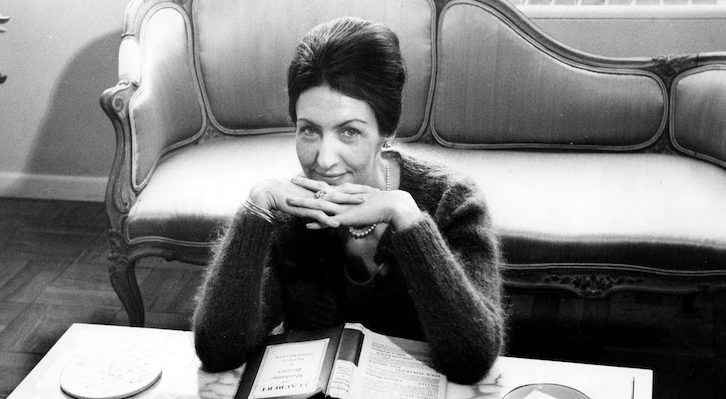
The Booker Revisited: Why Everyone Should Read The Bay of Noon by Shirley Hazzard
Lucy Scholes Reads Booker Prize Titles of Years Past
Strictly speaking, it would be inaccurate to describe Shirley Hazzard as neglected. All her work is still very much in print, and few who’ve read any of it would dare deny that they’re encountering a formidable talent. She’s also been awarded a number of impressive accolades: her third novel, The Transit of Venus (1980), won the National Book Critics’ Award, while her fourth and final work, The Great Fire (2003), secured her the preeminent literary prizes in both her native Australia (the Miles Franklin Award) and her adopted nation, the United States (the National Book Award for Fiction). It was also shortlisted for both the Man Booker Prize and the Orange Prize in the UK.
Then, seven years later, in 2010, her second novel, The Bay of Noon (1970)—the book I’m honing in on in this piece—was nominated for the Lost Man Booker Prize (the one-off prize to honour the books that missed out on the opportunity of being considered for the 1970 award, due to the date of the prize having been moved that year from April to November). Yet, for some reason, she remains woefully under-read.
This seems to have something to do with her rather languorous career. When she died in 2016, aged 85, Hazzard left behind a modest library. In addition to four novels—the three mentioned above were preceded by her debut, The Evening of the Holiday (1966)—there were two collections of stories: Cliffs of Fall (1963) and People in Glass Houses (1967). She published a memoir—Greene on Capri (2000), about her friend Graham Greene on the island that Hazzard herself made her home for many years, and where she got to know the British author – and a smattering of other non-fiction.
Although she published short stories throughout the 1960s—mostly in the New Yorker—when it came to her novels, Hazzard worked slowly and laboriously. According to her biographer, Brigitta Olubas, The Transit of Venus took over a decade to write, during which time Hazzard revised many of its pages up to an astonishing 30 times. Olubas’s brilliant biography illustrates that Hazzard lived as she wrote, recrafting and reshaping her own identity with the same meticulous attention to detail and nuance that marked her writing process. Born in dull, suburban Sydney (a place, she said, “that one might want to escape from”) and not formally educated beyond the age of 16, Hazzard ended up a respected and much-admired member of the New York intelligentsia, living an enviably cultured, cosmopolitan existence.
Hazzard was a writer slightly out-of-step with the late 20th century.
But there are other elements that underpin her lack of renown. Hazzard was a writer slightly out-of-step with the late 20th century. Her short stories and her first two novels are often described as Jamesian, and, indeed, her graceful, epigrammatic prose, always technically and morally exacting, has much more of an affinity with the style of 19th century writers than the work of many of her contemporaries.
And, like their creator, Hazzard’s heroes and heroines seem to have been flung out of an earlier era; “modern romantics” is how Zoë Heller describes them, people—again, like Hazzard herself—”who cleave to high feeling and high seriousness in a world largely hostile to their idealism.” So, too, is Hazzard tightly tethered to a particular moment in 20th-century history that, as she unhurriedly put pen to paper, was already slipping further and further into the past.
The Second World War was her great subject; not so much the conflict itself, but rather the bitter-tasting, fractured aftermath of this colossal and terrible schism that tore through the 20th century, uprooting lives “like a great syphon that sprayed human beings all over the globe,” as she described it in The Bay of Noon. Her characters are struggling to make sense of what’s been lost, but in shouldering “the huge disillusion of a ravaged world,” they’re also trying to find purchase in a future that feels impossibly tenuous. In an interview in the Paris Review in 2005, Hazzard goes as far as to call her final two novels explicitly “anti-war,” in that each ‘testifies in different ways to a world trying not to go to pieces under its burden of modern experience.
*
Born in Sydney in 1931, Hazzard was removed, both geographically and temporally, from the Second World War, but her entrance to adulthood coincided with its immediate aftermath; the traumatic devastation of which she encountered with her own eyes when, en route to Hong Kong in 1947—where her father was to take up his position as Australian trade commissioner—she and her family visited the ruins of Hiroshima. This was a watershed moment in the then 16-year-old’s life. The break from the parochial Australia of her childhood introduced her to the possibilities of a wider, more multicultural world, and henceforth she would strive towards cultivating an entirely different kind of life for herself.
More immediately, she was encountering first-hand, and for the first time, the devastations of war, which explains the dance between promise and horror that infuses The Bay of Noon, The Transit of Venus, and The Great Fire. Each book is a different take on a young woman’s sexual, emotional and intellectual awakening amongst wreckage and uncertainty.
Speaking on the Backlisted podcast in 2016, the author and playwright Alice Jolly explained that to read the Australian writer’s work is to enter “Hazzardland”—a reference, I suspect, not only to the extraordinary language of Hazzard’s prose, which is heightened to something almost incantatory, but to the emotional landscape of these novels. Hazzard’s characters all live emotionally precarious lives in materially precarious times.
Hazzard’s characters all live emotionally precarious lives in materially precarious times.
This is painstakingly but sensitively evoked in The Bay of Noon, which is set in post-war Naples, in a world that’s very much structured by the bureaucratic and organisational aftermath of the war. Although not as ambitious as the novels that follow it, and perhaps therefore somewhat maligned by comparison, Hazzard’s second novel is still incredibly accomplished; a jewel of a coming-of-age drama. It’s the story of a young, unworldly and impressionable Englishwoman—christened Penelope and known as Penny, but mistakenly renamed Jenny when she’s evacuated to Cape Town as a child—who arrives in Italy as a translator working with NATO.
Like so many of her generation, Jenny is used to being buffeted by the winds of history, and is left more than a little damaged as a result. Following the early death of her mother—a woman ‘depleted’ by the deprivations of wartime existence—she relocated from South Africa to Italian Somaliland to keep house for her older brother. His marriage then occasioned the siblings’ return to England, from where Jenny needed to escape because she was in love with him—a fact that, even after all these years, she admits with a strangely naïve honesty.
Reminiscent of Hazzard’s description, in the Paris Review, of her understanding of how the “private wars” of her parents’ marriage played out in tandem with the “global one,” these little hand-grenades of intimate trauma in Jenny’s life detonate against the backdrop of international conflict. Jenny is used to the story of her early “uprooting” being met with expressions of anguish in others. Yet, as she observes, “although the sufferings of children are the worst, being inextinguishable—children themselves seldom have a proper sense of their own tragedy, discounting and keeping hidden the true horrors of their short lives, humbly imagining real calamity to be some prestigious drama of the grown-up world.” The Bay of Noon recounts just one such “drama of the grown-up world,” a landscape within which “strands of love” wind their way, “entangling, strangling, wiggling,” between people across a crowded room.
When it comes down to it, the plot of The Bay of Noon is not especially complex. Jenny is looking back on her year in Naples, remembering her imbroglios with an older Italian woman named Gioconda; Gioconda’s married lover, Gianni; and her own beau, Justin, a rather dour Scots marine biologist she meets through her work. That this “game of sexual musical chairs,” as J.D. McClatchy describes it, descends into a tale of betrayal comes as no surprise, so for me to divulge that here doesn’t count as a spoiler.
No true admirer of Hazzard’s work reads it for her plots; it’s not that they aren’t successful, it’s more that they’re the least of the attractions on display. Instead, one reads Hazzard for the beauty of her prose, and the steady, studied poise of her syntax. The reader is thus left with the impression of a series of beautiful vignettes, explained perhaps by Hazzard’s illuminating confession in the Paris Review that, to a certain extent, she “see[s] life as “occasional” or ‘incidental,’ with episodes starting out from the dailiness of things.”
Inspired in no small part by her own youthful experience in Italy—while working for the UN Secretariat in New York in the 1950s and following a painful break-up, Hazzard took a secondment post in Naples for a year, which ignited her life-long love affair with the country—first and foremost The Bay of Noon is, in Hazzard’s own words, “a love letter to Naples,” and she evokes the city here with the hazy, somnolent quality of a rich and captivating dream.
That applies to both the city Jenny gets to know—its “assets […] so secret, they give the impression of having been deliberately concealed; lodged away, for the most part, in malodorous side-streets, embedded in some squalid recess, they partake of the city’s poverty”—and that which she’s told about: in blackout during the war, but lit by the eruption of Vesuvius behind it, “the entire region irradiated with a red glow […] It was real hell we were in,” Giaconda tells Jenny, “bathed in red, overhung by a sky of ash, smelling of fire and brimstone.”
Later in life, Hazzard and her husband, the biographer and translator Francis Steegmuller (who’d been left extremely well-off following the death of his first wife) split their time between Manhattan’s Upper East Side and homes in Capri and Naples. “Going to Europe was about as final as going to Heaven,” reads a line in The Transit of Venus, its heroine Caro’s experience of reinventing herself once she arrives in the northern hemisphere clearly inspired by the author’s own makeover: “A mystical passage to another life, from which no one returned the same.” In real life, Hazzard would revisit Australia, but never properly return. Her past really was a foreign country; by then, she belonged to America and Europe. It might not be her most accomplished novel, but nothing she wrote seems quite as close to her heart as the world she captures in The Bay of Noon.
_______________________

‘TBR: The Booker Revisited’, is an editorial partnership between The Booker Prize Foundation and Lit Hub.
Visit the Booker Prizes’ website for more features, interviews and reading recommendations covering the hundreds of books that have been nominated for its annual awards. Sign up for the Booker Prizes Substack here.
‘TBR: The Booker Revisited’, is an editorial partnership between The Booker Prize Foundation and LitHub.
Visit the Booker Prizes’ website for more features, interviews and reading recommendations covering the hundreds of books that have been nominated for its annual awards. Sign up for the Booker Prizes Substack here.
Lucy Scholes
Lucy Scholes is a senior editor at McNally Editions, and writes for The Independent, The Times Literary Supplement, The Observer, BBC, The Guardian, and is a columnist for The Paris Review.



















